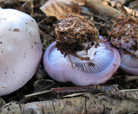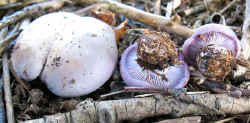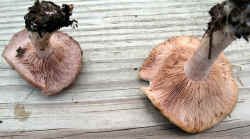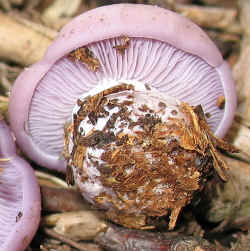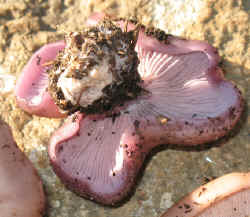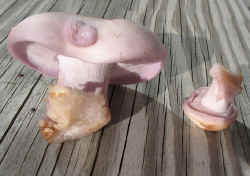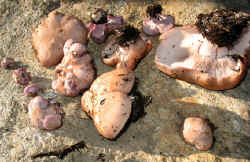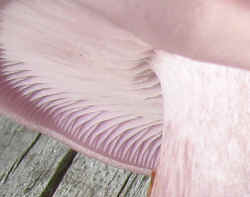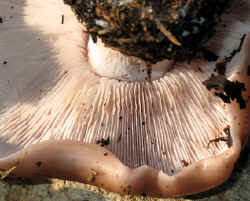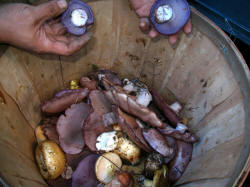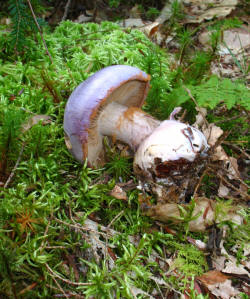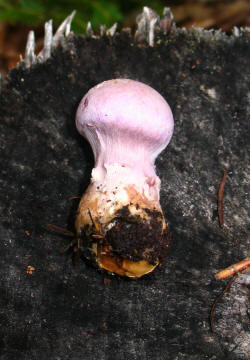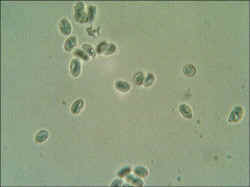|
|
A New England and Eastern Canada Edible and Medicinal Mushroom Resource |
|||
Home
Chanterelle (Cantharellus cibarius) Black Trumpet (Craterellus cornucopioides, C. cenerius, C. foetidus) Small Chanterelles (Craterellus tubaeformis, C. ignicolor) Hedgehog (Hydnum repandum, H. umbilicatum) Horse and Meadow Mushroom (Agaricus arvensis, A campestris) Parasol Mushroom (Macrolepiota procera) Shaggy Mane (Coprinus comatus) (White) Matsutake (Tricholoma magnivelare) Blewit (Lepista nuda) Oyster Mushroom (Pleurotus ostreatus, P. populinus)
King Bolete (Boletus edulis) Boletus variipes and other. Two Colored Bolete (Boletus bicolor) Maitake (Grifola frondosa) Chicken of the Woods (Laetiporus sulphureus) Dryads Saddle (Polyporus squamosus)
Morels (Morchella esculenta, M. elata) Puffballs (Calvatia gigantea, Calvatia cyathiformis, others) Lobster Mushroom (Hypomyces lactifluorum) Aborted Entoloma (Entoloma abortivum)
Medicinal Mushrooms Maitake (Grifola frondosa) Reishi (Ganoderma tsugae, G. lucidum) Turkey Tail (Trametes versicolor) Chaga (Inonotus obliquus) Artist's Conk (Ganoderma applanatum)
Collecting, Photographing and
Cooking Collecting
Tips Evaluating
Flavor Dyeing Fabrics and Paper with Mushrooms
|
Blewits
When the maitake and king bolete season starts to fade it can seem like the exciting time of mushroom season is over. If you persist in looking around the oaks and edges you are likely to spot blewits. These are a very distinctive tasting mushroom whose flavor is hard to describe. I hesitate to say bitter, though it may have a slight bitter edge. It has a nice fairly strong flavor that can only be described as blewit-flavored. Cap (pileus) 1-6 in. bluish lavender color convex with inrolled edges when young with a shape somewhat similar to a button mushroom becoming broadly convex as it matures often developing an upturned wavy edge and tending to fade toward tan with age. They seem to maintain their color better in shadier locations. It has a fragrant aroma. Gills are lavender fading toward tan/brown with age close together and often with a notched attachment to the stem. Stem (stipe) Young specimens are likely to have a thick stem that is enlarged at the base and 1 inch or less in length. The stem can stretch out to several inches as it ages fading toward tan. If mycelium is attached at the base it will have a slight bluish lavender tint. Flesh is whitish lavender. Spores are whitish buff with possibly a slightly pinkish tint. When and where to find them (ecology) When the nights start getting cold and approaching frost temperatures the Blewits start to grow. This will usually be mid to late October or slightly later. They can continue into December if the weather stays somewhat mild. Moderate December temperatures are more likely in coastal areas. Places with compost such as grass clippings, wood chips and wood waste from raking seem to be best. The natural compost created on the ground around oaks and other hardwoods can harbor blewits. Around the edges of parks and cemeteries where the landscapers dump this type of refuse are a good bet as well as areas where lawns border woods and bushes. They grow around the berry bushes at the edge of the woods by my driveway. They can be harder to identify if they are older because of the tannish brown color and stretched out profile they develop. As with many mushrooms every once in a while a really huge one will appear which can be confusing. Such was the case this last fall when I was shown some growing inside a local greenhouse. They had faded to tan brown and one of them was 9 inches across! I consulted other knowledgeable collectors online to see what they thought. I discovered that the gills will still maintain a slight hint of color. Looking at the color of the interior flesh can help also. Preparation: Don't sample these raw. Cook them. The flavor of this mushroom can hold it's own fairly well in a mixed dish if you are somewhat careful not to add anything with overpowering flavor. Veal, pork, fish, poultry, cheese, rice, pasta are good choices. These mushrooms are best sampled sautéed or by other simple processes to appreciate the uniqueness of the flavor before doing anything fancy with them. You really need to know what to expect with these. Recipes showcasing the blewit flavor are recommended. I have enjoyed them immensely sautéed, deep fried in tempura batter, and microwaved. Whether deep lavender or tan in color they seem to all become similar in color in the frying pan with a slight lavender tint. Mycologist Greg Marley made a blewit white pizza for the Maine Mycology Assoc. 2006 annual meeting that was awesome (his black trumpet pizza was also outstanding). I have not found enough to dry them. For the sake of "science", I promise to collect and dry some in the coming year. Comments: There are other mushrooms that are lavender or purple. Cortinarius species have a cobwebby veil. All cortinarius species should be avoided. Always. Entolomas (avoid) are likely to have thinner stems and a salmon/rouge color spore print. Other species may have brown spore prints and are more likely to occur earlier in the season. Be sure to make a spore print. When in doubt throw it out(side)! Blewits are relatively easy to propagate. I have put a clean fruit body into a jar filled with unsterilized, fresh clean hardwood sawdust and gotten fairly vigorous mycelial growth. Once the mycelium began showing signs of growth, I pulled the mushroom out so it would not fester. I put the mycelium into compost-like soil outside my house. Blewits can be used for dyeing textiles or paper and will yield a grass green color when cooked in an iron pot. Find more information here: Clitocybe
nuda at MushroomExpert.com
Copyright
2012 Mushroom-Collecting.com. All rights
reserved. |
